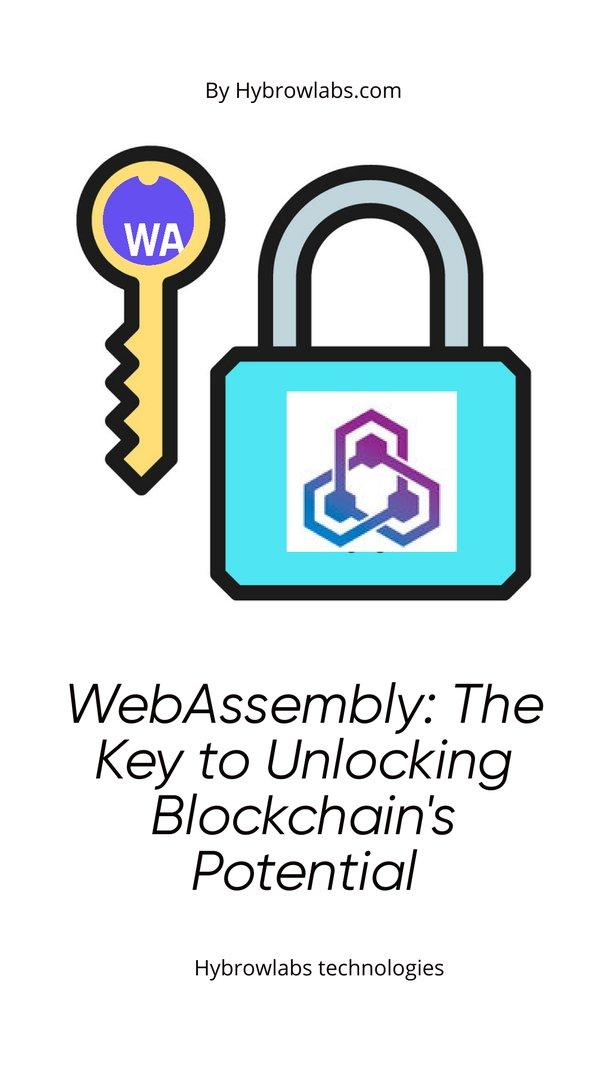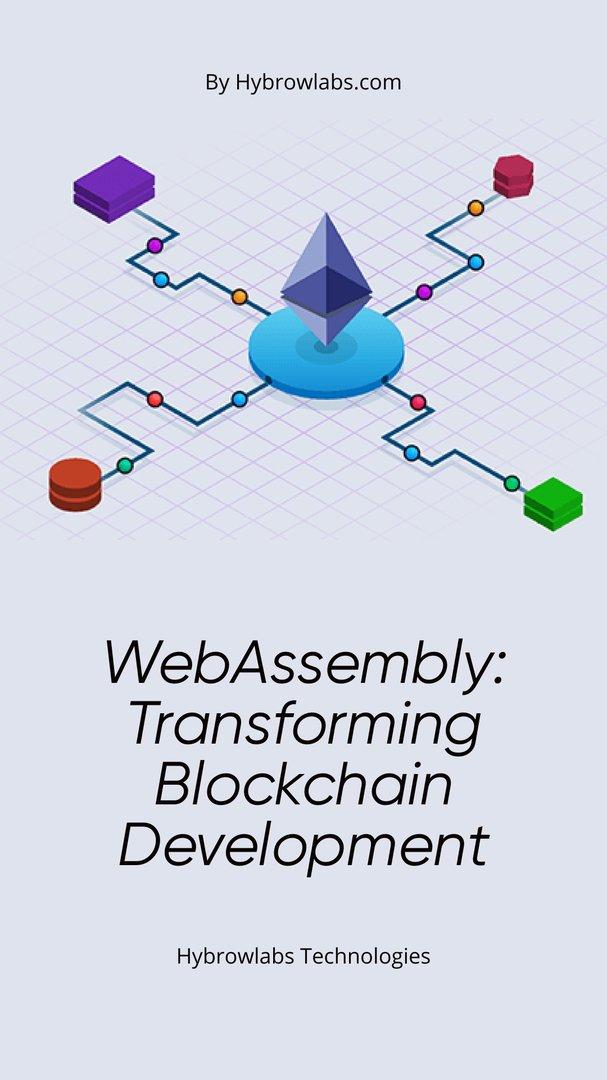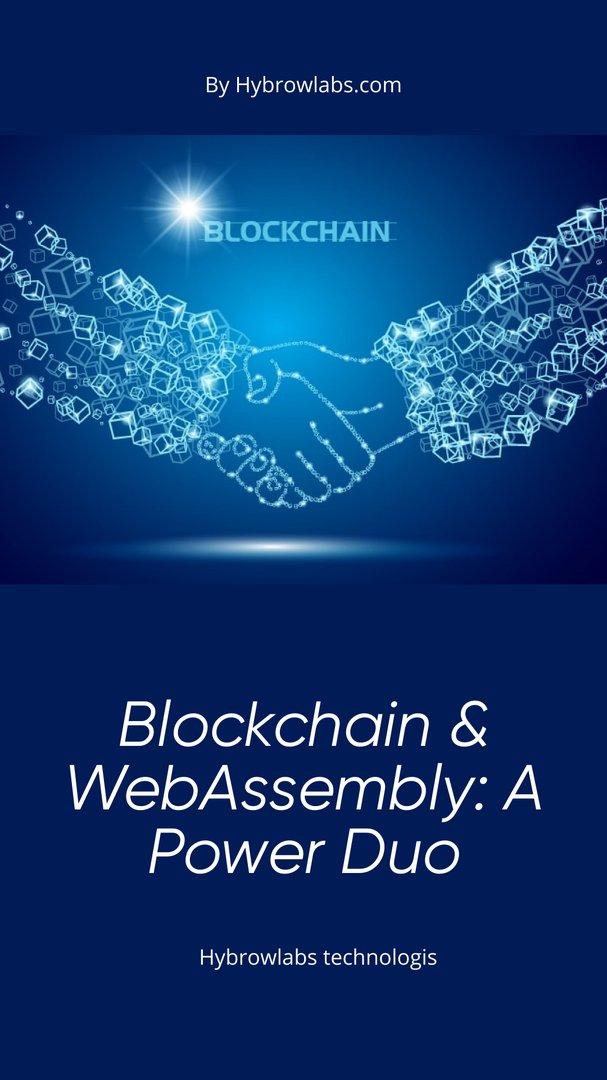Blockchain and Web Assembly: A brief:
Blockchain technology is rapidly advancing, with its potential to transform industries becoming increasingly clear completely. However, the intricacy of developing blockchain has resulted in significant difficulties for numerous developers seeking involvement. Recently, WebAssembly has emerged as a promising resolution to this challenge.
Implementing blockchain technology has led to a revolution in various sectors by providing a secure and transparent system for digital asset exchange. Nevertheless, the process of creating blockchain applications can be a daunting and protracted endeavor. WebAssembly has surfaced as a hopeful solution to streamline the development of blockchain technology and make it more accessible to a broader spectrum of programmers.
What do you mean by WebAssembly?
WebAssembly is a binary format that functions at a low level and possesses the capability of being executed within web browsers and akin environments. Its design is tailor-made to serve as a portable target for high-level programming languages such as C, C++, and Rust. Employing WebAssembly provides a multitude of benefits, foremost of which is its ability to facilitate swift, efficient, and secure execution of code within web browsers. This empowers developers to construct elaborate applications that operate with performance on par with that of native applications.
Why is WebAssembly Important for Blockchain Development?

Developing blockchain technology can present a convoluted and demanding undertaking, and the intricacy of smart contracts constitutes a substantial obstacle to entry for countless developers. Nevertheless, WebAssembly can streamline the development procedure by enabling developers to compose smart contracts using high-level programming languages and subsequently compile them to WebAssembly. This grants a more accessible path for developers to participate in blockchain development and diminishes the resources and time necessitated for generating smart contracts.
What is the relationship between WebAssembly and smart contracts?
Smart contracts represent self-executing contracts encoded onto the blockchain, designed to automate intricate financial transactions, with their execution ensured by the blockchain's decentralized architecture. WebAssembly offers the ability to create smart contracts using high-level programming languages that can subsequently be compiled into WebAssembly code and executed on the blockchain. This method streamlines the creation of complex smart contracts for developers and elevates the overall efficiency of the blockchain.
Advantages of using WebAssembly for blockchain development

Using WebAssembly (Wasm) for blockchain development has a number of benefits. Here are a few of the main advantages:
(i) Performance-based:
Low-level bytecode that can be performed quickly and effectively on a variety of systems is what WebAssembly is intended to be. Because of this, it is perfect for blockchain development, where effectiveness and performance are crucial.
(ii) Portability:
Any platform that supports it, such as web browsers, servers, and even embedded devices, can be configured to run web assembly code. It is simple to write code once and run it wherever as a result.
(iii) Safety:
Sandboxing and memory isolation are two characteristics of WebAssembly's security-focused design that guard against malicious programmes infiltrating the system. In the context of blockchain, where security is of utmost importance, this is extremely significant.
(iv) Compatibility:
Developers may quickly create dApps utilising a variety of tools and frameworks thanks to WebAssembly's simplicity of integration with existing blockchain platforms and programming languages.
It is an attractive area of development for blockchain developers since the combination of WebAssembly with blockchain has the potential to dramatically enhance the performance, security, and scalability of decentralised apps.
What are the potential use cases of WebAssembly in blockchain development?
The WebAssembly (Wasm) technology has a variety of useful applications in the field of blockchain development. The following lists some use cases:
(i) Decentralized apps (dApps):
By utilising the performance advantages of Wasm technology, developers may create dApps that are quicker, more secure, and more scalable and that can run on the blockchain. A wide range of applications, including social networks, gaming, and financial services, now have more prospects as a result.
(ii) Interoperability:
With the help of Wasm technology, programmers may build cross-platform blockchain apps that are compatible. This permits increased adaptability and compatibility amongst various blockchain platforms.
(iii) Tokenization:
Wasm technology can be used to build platforms for the production and management of digital assets on the blockchain, a process known as tokenization. As a result, programmers may design unique tokens that are safe, scalable, and compatible with other blockchain platforms.
(iv) Decentralized finance (De-fi):
Developers can create decentralised financial (DeFi) applications on the blockchain by utilising the Wasm technology. Decentralized platforms for lending, borrowing, and trading are among these applications. Wasm technology enables DeFi applications that are faster, more secure, and more scalable than conventional financial applications.
Overall, WebAssembly has a wide range of use cases in blockchain development, enabling faster, more secure, and more scalable decentralized applications.
How is WebAssembly Transforming Blockchain Development?
By offering a high-performance, secure, and portable environment for running decentralised apps (dApps) and smart contracts on the blockchain, WebAssembly (Wasm) transforms blockchain development. Here are some ways that WebAssembly is altering the development of blockchains:
(i) Compatibility with a variety of programming languages
WebAssembly can be used with a wide range of programming languages because it is intended to be language-agnostic. Because of this, creating smart contracts and decentralised applications (dApps) in their favourite programming language and compiling them to execute on the blockchain is made simpler for developers.
(ii) Enhanced productivity and scalability
Due to its high speed design, WebAssembly makes it possible for blockchain-based dApps and smart contracts to run more quickly and effectively. This can increase the scalability of blockchain networks and make it possible to develop applications that are more intricate and advanced.
(iii) More privacy and security
With features like memory separation and sandboxing to prevent malicious programmes from compromising the system, WebAssembly is built with security and privacy in mind. Blockchain applications may become more secure, private, and attack-resistant as a result.
Overall, WebAssembly is revolutionising blockchain development by enabling smart contracts and decentralised applications (dApps) to run more quickly, effectively, and securely on the blockchain. It is the perfect platform for creating the upcoming generation of blockchain apps due to its language independence, security features, and performance advantages.
WebAssembly and Blockchain Development: What Does the Future Hold?
1. What are the Latest Industry Trends and Future Predictions?
The future of blockchain development with WebAssembly looks bright, with many industry experts predicting that the combination of these two technologies will drive the next wave of innovation in the blockchain space. Here are some industry trends and predictions:
(i) Continued adoption of WebAssembly:
As more developers become familiar with WebAssembly and its benefits, we can expect to see greater adoption of this technology in the blockchain space. This will enable the creation of faster, more efficient, and more secure decentralized applications and smart contracts.
(ii) Greater interoperability:
WebAssembly has the potential to enable greater interoperability between different blockchain platforms and programming languages. This can increase the adoption of blockchain technology and enable the creation of more complex and sophisticated applications.
(iii) A stronger emphasis on security and privacy:
We may anticipate that privacy and security will receive more attention as the blockchain sector develops. Blockchain applications can be made more safe by utilising WebAssembly's security capabilities, such as memory separation and sandboxing, which can help allay some of these worries.
2. WebAssembly in Blockchain: What Challenges and Limitations Should You Be Aware Of?
WebAssembly has a lot of advantages for developing blockchain applications, but there are also certain difficulties and restrictions. The key obstacles are as follows:
(i) Complexity:
Web assembly is a relatively new technology, therefore it could take some time and money for developers to learn how to use it effectively.
(ii) Restricted capabilities:
WebAssembly can make smart contracts and dApps execute more quickly and effectively, but it might not be the best choice for apps that need more advanced features.
(iii) Possibility of bugs and weaknesses:
WebAssembly is still susceptible to faults and weaknesses that attackers could exploit despite its security protections that guard against malicious code from infecting the system.
Overall, WebAssembly has the potential to revolutionize blockchain development by enabling faster, more efficient, and more secure execution of smart contracts and dApps. While there are some challenges and limitations to consider, the benefits of WebAssembly for blockchain development are clear, and we can expect to see continued innovation in this space in the years ahead.

Conclusion:
As a result of offering a safe, effective, and portable environment for running decentralised applications and smart contracts on the blockchain, WebAssembly is revolutionising the development of blockchain technology. It is the perfect tool for creating the upcoming generation of blockchain apps due to its language independence, security features, and high performance capabilities.
Developers and businesses must stay current with the newest trends and technology as the blockchain sector continues to expand. We can unleash the full potential of blockchain technology and encourage more innovation and acceptance in the next years by embracing WebAssembly and its advantages.
Our call to action is for developers and businesses to explore the potential of WebAssembly in blockchain development and start experimenting with its capabilities. By collaborating and sharing knowledge, we can accelerate the growth of this exciting new field and build a better, more secure, and more efficient blockchain ecosystem for all. Utilizing services like Hybrowlabs WebAssembly Development services can provide valuable support in this endeavor.
FAQ’s
1. In what ways is WebAssembly unique from existing blockchain technologies?
Although it can run on many platforms, including blockchains, WebAssembly is not a blockchain technology in and of itself. Its performance, security, and portability can, nevertheless, give it a number of advantages over other smart contract platforms.
2. What advantages come with using WebAssembly for creating smart contracts?
The performance, portability, and security of smart contract development can all be enhanced by using WebAssembly. It allows programmers to create smart contracts in a variety of programming languages, compile them to WebAssembly, and then run them on different blockchain platforms.
3. Is WebAssembly compatible with current blockchain protocols?
Absolutely, the current blockchain protocols can use WebAssembly. It is a versatile and transportable technology that can be combined with many blockchain platforms, such as Ethereum, EOS, and others.
4. What improvements to blockchain applications' security and privacy does WebAssembly make?
The built-in security features of WebAssembly, such memory segregation and sandboxing, which stop malicious code from infiltrating the system, can improve the security and privacy of blockchain applications. Also, it enables programmers to create smart contracts in a variety of languages, which can lower the likelihood of flaws and vulnerabilities brought on by coding mistakes.
5. Is WebAssembly the technology of choice for creating blockchains?
Future blockchain development could benefit greatly from the use of WebAssembly. Building decentralised applications and smart contracts is made appealing by its performance, portability, and security advantages. The future of blockchain development may potentially involve the use of other technologies, and there are still issues and restrictions to take into account.







a3dc85.jpg)

.jpg)
fd8f11.png)


.jpg)
.jpg)